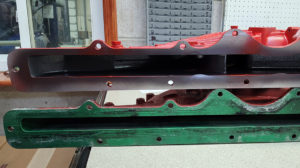Some customers will come to us and ask, “Why do I need a new intake manifold on my ISX? Isn’t stock good enough?” The short answer is, yes, the stock intake manifold is perfectly adequate – if you are looking for stock performance! At Pittsburgh Power, we offer the Full Tilt Performance manifold for the ISX engine that will fit the 2011 to 2019 models. But I can already hear you asking, “What’s the big difference?” The difference is in the way the manifold is made.
I did not believe the differences until we recently did a side-by-side comparison in the shop. A customer had just removed his stock manifold and brought it in for us to inspect. While inspecting the intake, we brought a Full Tilt manifold in out of curiosity and took a few pictures for reference. They say a picture is worth a thousand words, and in this case, I believe that to be true. Simply by looking at them together, you can see a substantial difference in the manifold porting – almost half an inch (the Full Tilt manifold is on top).
With the Full Tilt intake’s larger porting, there is a significant difference in the amount of air reaching the cylinders, but there are also additional measures taken by Full Tilt Performance to make sure that all of the cylinders get an equal amount of air, as well as increase the velocity of that air. When being compared, you can distinctly see that the stock manifold is designed in such a way that lowers the efficiency of the engine. It is designed to make the airflow travel to the back of the manifold and return to reach the front two cylinders. Full Tilt has rectified this by adding an internal fin that reflows the air to reach all the cylinders equally.
With this improved design, Full Tilt Performance has increased efficiency by lowering restrictions and increasing the amount of clean air reaching the engine. That little bit of extra space really does make a huge difference! Dyno testing has also shown that the Full Tilt intake manifold shows a reduction in emissions, and there are also potential increases in mileage and horsepower. Swapping your stock manifold for maximum efficiency and power seems like a no-brainer to us!
Moving on to another topic, please be careful when rebuilding or purchasing parts for the older Big Cam Cummins engines – you must know the CPL (Control Parts List). There are seven different versions of the Big Cam engine, and many of the parts are not interchangeable. We are receiving phone calls from owner operators that were trying to build one of these engines and have been given incorrect information from someone who thought all Big Cams were the same.
The oldest five employees at Pittsburgh Power have 158 years of combined experience with this engine, and we have many of the parts for it in stock. You can save yourself thousands of dollars of lost revenue if you call me, Pete, or Brian before starting to build one of these engines. There are many compression ratio pistons, different camshafts, injectors, fuel pump settings, the timing of the injectors, ceramic and Teflon coated pistons, and turbochargers available, and all must match to build a great running, smoke-free, and fuel-efficient Big Cam Cummins engine.
Our average build for the Big Cam Cummins is 550 to 600 horsepower, but more horsepower is available. However, you, as the operator, must be considerate of the aluminum pistons. For racing or sled pulling, 1,000 or more horsepower is available. We are here to help! We love building these engines and making people happy, so call us today if you a Big Cam project and want advice or help. Visit our shop in Saxonburg, PA or call (724) 360-4080. You can also visit our website at www.pittsburghpower.com anytime.

